 |
Stories & Legends
The Investiture of the Knight
Hugh O’Reilly
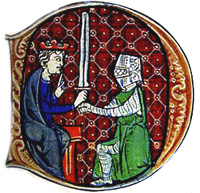
A King investing a knight |
It is the vigil of Pentecost. There is much movement in the castle. In the great hall the mother of the candidate to knighthood arranges the white vest, golden spurs and ermine tunic that her son will wear the next day. In the entrance hall, a group of troubadours and minstrels who came to commemorate the event, plays, sings and performs acrobats; the poor have come to ask for alms.
After the poor and the minstrels have left, buckets and large basins are brought in for the ceremonial baths of purification for those who will receive the sacramental: the youth of the castle and his companions - cousins, friends and peers. After the bath the youth dress in heavy silk white robes embellished with gold and silver. Over this they wear tunics of ermine with grey tones.
From the castle they walk to the Church where the aspirants to Chivalry will make an all-night vigil in the choir balcony.
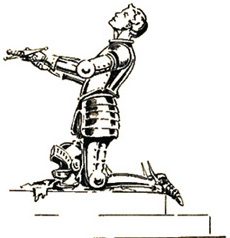
The candidate keeps an all-night vigil before the altar |
In the morning they assist at Mass, and then return to the castle, where a great meal is prepared: a good breakfast with white bread and fresh game.
The mother had already laid out for her son a white shirt and pants “whiter than snow and the April flowers,” symbolizing purity. The godmothers, who came to assist at the investiture, dress the candidate in his red hood and mantle, typifying the blood he should be willing to shed for Holy Church. At the sharp call of the long trumpets, the ceremony begins.
Over the green lawn that spreads out from the castle walls, the servants have unrolled carpets. There the youth is invested with his arms by his godfathers. The steel mail tunic is drawn over his head to cover the shirt. His father approaches, and with a grave gesture, fastens the sword on the left side of his son’s belt. The youth feels a trembling of emotion. He kisses the top of the sword handle that contains a relic.
In a deep voice, his father says: “Bow your head.” Then he gives a strong blow to the back of the youth’s head. Next, joyful and filled with emotion, he embraces his son, who has become his peer, his equal, at least in that which regards Chivalry.
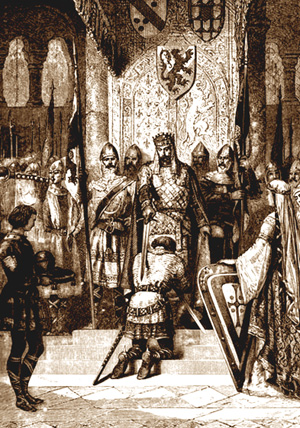
A baron gives the accolade to the new knight |
The ceremony of investiture, properly speaking, has ended. The squires bring to the youth a horse called Vigilance, in homage to the horse of Charlemagne.
Those assisting at the ceremony ask themselves, “Is he a good rider?” In a single leap, the new knight is in the saddle, a ritual that became obligatory. From the crowd one hears two words that circulate as a murmur of admiration: “Without stirrups!”
Then squires bring him his lance and a large curved shield painted with golden lions that can cover him head to toe. From the point of the lance hangs a long, thin war standard ending in three points that reaches down over the helmet of the young warrior when he holds the lance upright.
The new knight must prove before the spectators his prowess in riding. He canters round to warm up his horse, and then, the test - the quintaine: a wood mannequin dressed as a knight on a post that he has to bring to the ground with just one blow of the lance.
“Raise the quintaine,” The master of the ceremony shouts. The youth gallops toward it holding his lance firm. When the quintaine is knocked down with a single blow, the crowd applauds.
Fealty and Chivalry
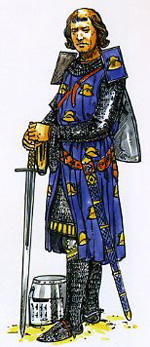
The armed knight |
Leon Gautier, a famous historian of Chivalry, observes:
“In the 12th and 13th centuries a magnificent blow in the quintaine was enough to establish a man’s success, just as a magnificent speech does in our days (the 19th century).” When, under the experienced gaze of Charlemagne, Ranaud de Montauban knocked the post to the ground with a single blow, the Emperor exclaimed with enthusiasm: “You will be the seneschal of my Empire!” A man so adept, who with such a vigorous and decided blow could knock down the quintaine, could hardly be less adept in administrating the state.
In the rules of Chivalry, one reads:
“The knight must show himself to the people of his area so that they will know that he is a recently invested knight, obliged to defend and maintain the elevated honor of Chivalry. Doing so, the chevalier will know how to restrain himself from carrying out any evil action, realizing the great shame that such would be inflicted on him by those who serve Chivalry. In this way, he will do all that he can to avoid transgressing the Order of Chivalry.”
Upon returning to the castle, more songs and merriment end the long feast. The last thing to do is to drink the vin à coucher [a wine to sleep] and go to bed.

Based on and translated from Funck Brentano, Feodalite et Chevalerie, p. 172.
Posted January 19, 2008
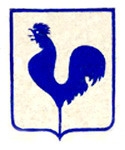

Related Topics of Interest
 Hernan Perez del Pulgar, “He of the Valiant Deeds” Hernan Perez del Pulgar, “He of the Valiant Deeds”
 Honor, a Counter-Revolutionary Virtue Honor, a Counter-Revolutionary Virtue
 Theophilus: The Man Who Sold His Soul to the Devil Theophilus: The Man Who Sold His Soul to the Devil
 Papal Knighthood Given to a Jewish Rabbi Papal Knighthood Given to a Jewish Rabbi
 The King of Spain Dishonors the Golden Fleece Order The King of Spain Dishonors the Golden Fleece Order
 The Epic Journey of Don Juan de Oñate The Epic Journey of Don Juan de Oñate
 The Peasant-Nobles of Roncal Valley The Peasant-Nobles of Roncal Valley
 The Debasement of Knighthood The Debasement of Knighthood

|
Legends | Religious |
Home | Books | CDs | Search | Contact Us | Donate

© 2002-
Tradition in Action, Inc. All Rights Reserved
|
 |
|